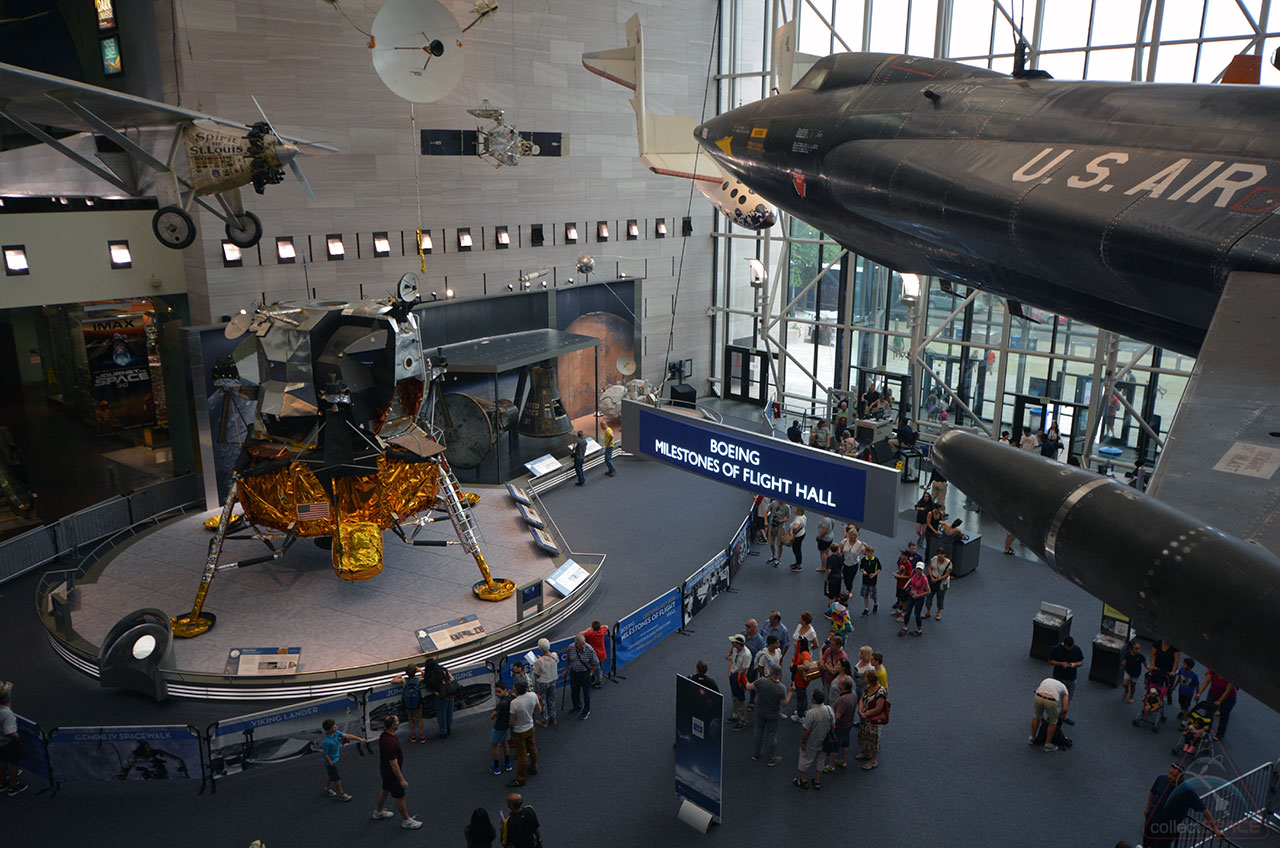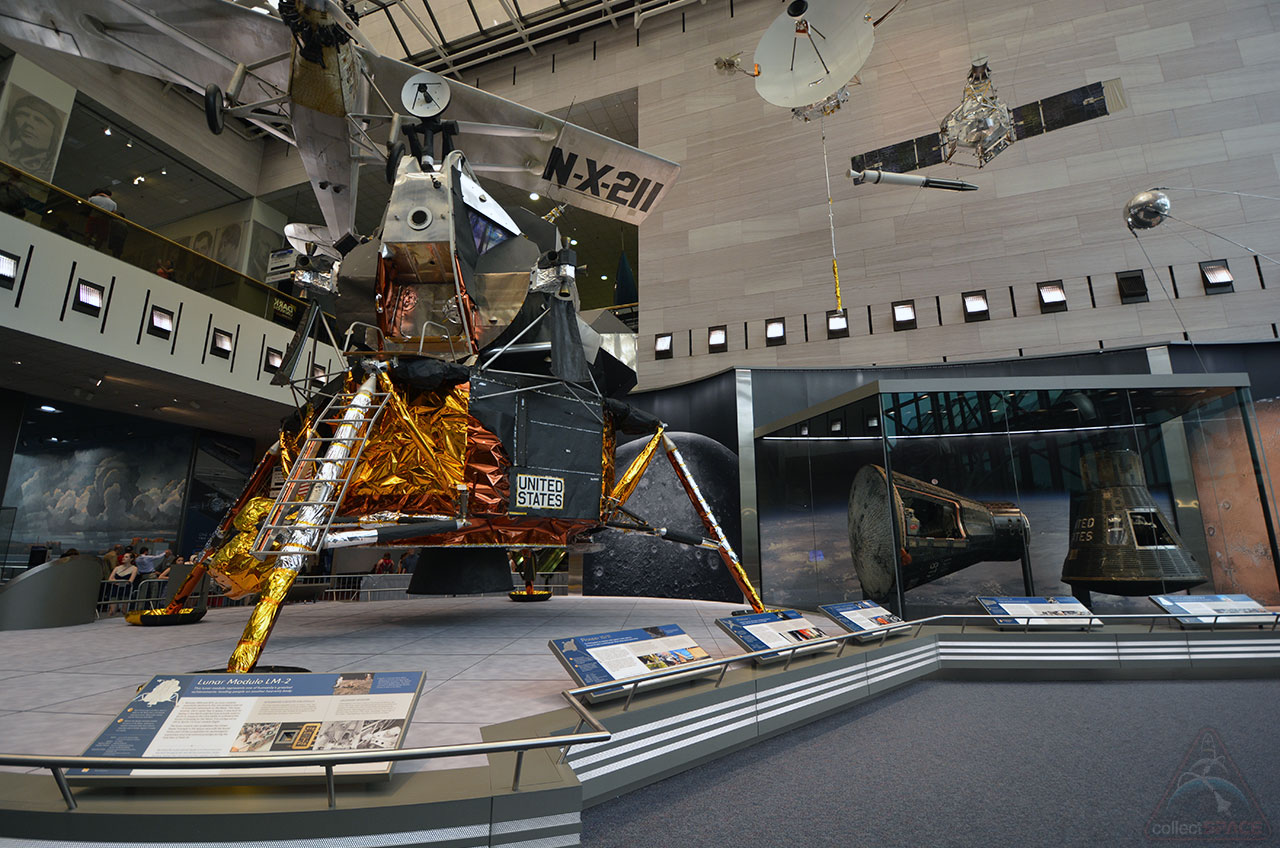First Look at Air and Space Museum's New 'Milestones of Flight' Hall

WASHINGTON, D.C. — After 40 years, the National Air and Space Museum finally has its elephant.
The proverbial pachyderm, in this case a restored Apollo lunar module gleaming with gold foil and a silverly metal skin, is now one of the first artifacts the public will encounter as they enter the Smithsonian museum's newly-renovated central hall, the Boeing Milestones of Flight.
Gen. Jack Dailey, the director of the Air and Space Museum, likens the moon lander to the iconic exhibit of a mounted African Elephant that guests first encounter inside the nearby Museum of Natural History on the National Mall in Washington, D.C. [Photo Gallery: First Look at Boeing Milestones of Flight Hall]
"The heart of the museum lives here," said Dailey at a press preview of the new Milestones of Flight gallery, which opens to the public on Friday (July 1), marking the 40th anniversary of the National Air and Space Museum. "This hall is a place of discovery and exploration, and truly one of the world's great public spaces."
The re-arranged and, as Dailey describes it, "transformed" Milestones of Flight still stretches between the museum's two entrances, but now features a streamlined, modern design that introduces guests to the types of aviation and space treasures that are contained within the building's other galleries.
"This serves very well as a table of contents for what is in the museum," said Allan Needell, the curator who oversaw the relocation and restoration of the Apollo lunar module. "We can't have everyone just dwell in this [hall] for the whole time — they'd miss everything else we have in the whole building — so it is designed in such a way to help you understand what else is here, and give you some background, some introduction to what you will find."
A milestone for Milestones
As the Air and Space Museum's central space, the 19,000-square-foot (1,765 square meters) Milestones of Flight Hall has welcomed 327 million visitors since it opened on July 1, 1976. Largely unchanged for the past 40 years, it has now undergone its first major redesign, a two-year renovation made possible by a $30 million gift by The Boeing Company.
Get the Space.com Newsletter
Breaking space news, the latest updates on rocket launches, skywatching events and more!
The Apollo lunar module is one of several new additions to Milestones. Also new to the hall is the Discoverer XIII satellite re-entry capsule, the first human-made object to be recovered from orbit; the backup to Telstar I, the world's first active communications satellite; and the studio model of the Starship Enterprise from the original "Star Trek" television series that first aired 50 years ago this September.
"Rethinking what we mean by a 'milestone' at the National Air and Space Museum allowed us to think about inspiration and imagination as important themes that run through all kinds of aviation and spaceflight stories and really could be summed up and symbolized in that one piece," said Margaret Weitekamp, who, as curator of the museum's social and cultural dimensions of spaceflight collection, championed the inclusion of the Enterprise in Milestones.
Still on display inside the hall, although in new locations, are Charles Lindbergh's Spirit of St. Louis monoplane, Chuck Yeager's Bell X-1 supersonic airplane, John Glenn's Friendship 7 orbital capsule and the Gemini 4 spacecraft. SpaceShipOne and the X-15 rocket plane still hang from the ceiling, and the engineering backup to the Viking 1 Mars lander remains on exhibit.
Guests can also still touch a real piece of the moon, one of the few moon rock touchstones in the world.
"These things don't change. This is history," said Dailey. "These are the machines that made things happen and set those milestones, which is what this is about." [Gallery: Smithsonian National Air and Space Museum: America's Aerospace Treasures]

Modern Milestones
While many of the artifacts have not changed, the way in which the public interacts with them has. In addition to revealing the new layout for Milestones, the National Air and Space Museum is also introducing a new digital experience.
"The Boeing Milestones of Flight Hall will serve as the model for our new approach to more interactive, dynamic exhibitions and enable us to share the story of flight like never before," Dailey said. "With our new digital experience launching along with the gallery on July 1, we're poised to take our mission beyond the walls of the museum."
Three components make up the museum's new "GO FLIGHT" experience — a 16 by 12 foot (5 by 4 m) interactive wall in the Milestones Hall, a mobile app and a redesigned website. Whether onsite or online, users can use the technology to "favorite" artifacts, allowing them to design personalized tours of the museum and explore unexpected connections with other items in the collection.
A key part of the GO FLIGHT experience is the ability for users to share their own stories within the app and on the website.
"We are transforming this museum from the icon it has been for the past 40 years by preparing it for the future," said Dailey. "We don't know exactly what that is. We don't know what a visitor in 10 years is going to want to see or how they would want to see it, but we're trying different things."
See more photos of the new Boeing Milestones of Flight Hall at the Smithsonian’s National Air and Space Museum.
Follow collectSPACE.com on Facebook and on Twitter at @collectSPACE. Copyright 2016 collectSPACE.com. All rights reserved.
Join our Space Forums to keep talking space on the latest missions, night sky and more! And if you have a news tip, correction or comment, let us know at: community@space.com.

Robert Pearlman is a space historian, journalist and the founder and editor of collectSPACE.com, a daily news publication and community devoted to space history with a particular focus on how and where space exploration intersects with pop culture. Pearlman is also a contributing writer for Space.com and co-author of "Space Stations: The Art, Science, and Reality of Working in Space” published by Smithsonian Books in 2018.In 2009, he was inducted into the U.S. Space Camp Hall of Fame in Huntsville, Alabama. In 2021, he was honored by the American Astronautical Society with the Ordway Award for Sustained Excellence in Spaceflight History. In 2023, the National Space Club Florida Committee recognized Pearlman with the Kolcum News and Communications Award for excellence in telling the space story along the Space Coast and throughout the world.










